14 Common Wok Mistakes Everyone Makes
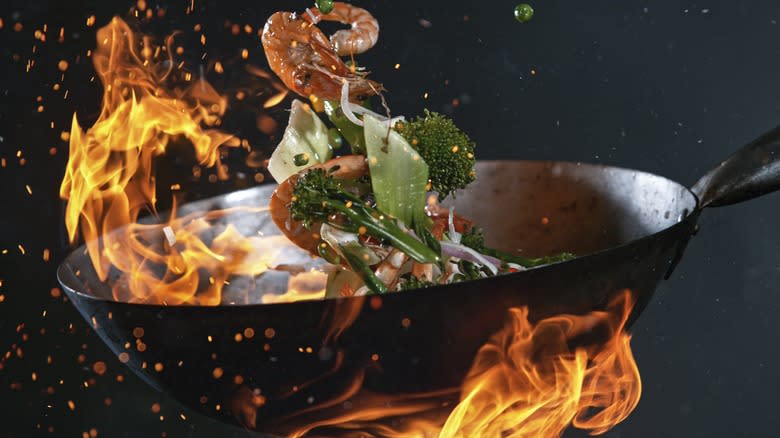
Cooking with a wok can be fairly intimidating -- not least because it's all too easy to make mistakes. Woks may be a standard piece of cookware for millions of people, but they have their own specificities which make using them different from a high-sided pot or frying pan. Picking the wrong style of wok, or grabbing one made out of the wrong material, can confuse you as to why your stir-fry didn't turn out the way you'd hoped. Using the wrong technique, adding your ingredients incorrectly, or using a heat that's too low can also ruin your food.
This is all the more frustrating, as once you learn the basics of wok cooking, you might never use another pan again. Woks are highly versatile pieces of cookware, and they have a capacity for even heat distribution that gives you a uniform result time and time again. Their larger size also gives you the space required to get a proper sear on your food, and when treated properly, they can last for years, requiring minimal upkeep and cleaning. That's all if you can avoid those classic mistakes, that is. To help you do so, we spoke to Namiko (Nami) Hirasawa Chen, the creator of Just One Cookbook, to get the lowdown on how to use a wok properly, and we have a few tips of our own, as well.
Read more: The Best Kitchen Gadgets You Can Buy
Using A Wok With The Wrong Bottom
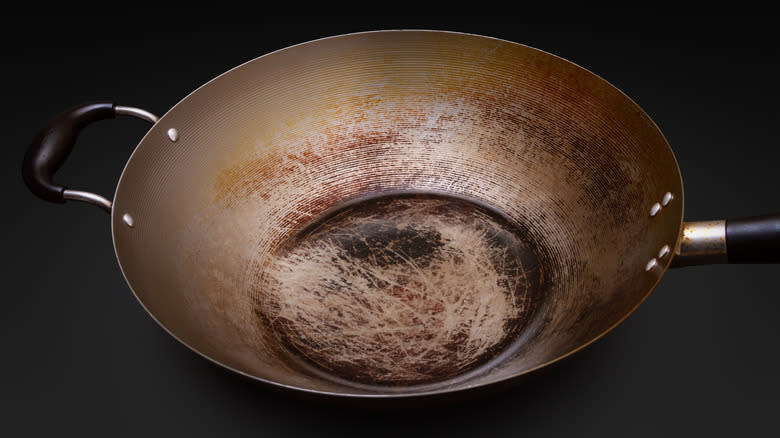
Woks are traditionally used on gas stoves, with their round bottoms licked by the fire underneath. In the age of electric, induction, and ceramic cooktops, though, woks have had to adapt, and flat-bottomed models have become more popular.
However, it's crucial to remember that the two styles are often not interchangeable. When placed over a concentrated flame, flat-bottomed woks can often build up too much heat and end up burning the food at the bottom of the pan. Round-bottomed woks, meanwhile, simply do not have enough contact with the flat surface of electric or induction hobs to build up sufficient heat. They also have an annoying tendency to roll around on the top of these cooktops, creating instability when you're cooking your fried rice that can be both annoying and dangerous.
Instead, you should always buy the right wok for your stove. Remember that both flat-bottomed and round-bottomed woks come in a range of sizes and materials, so you'll likely be able to find one that fits your specifications. If you're uncertain about which style to buy, flat-bottomed woks generally work pretty well for most home kitchens and will work just fine on gas cooktops, provided you don't blast them with too much heat.
Forgetting To Season Your Wok
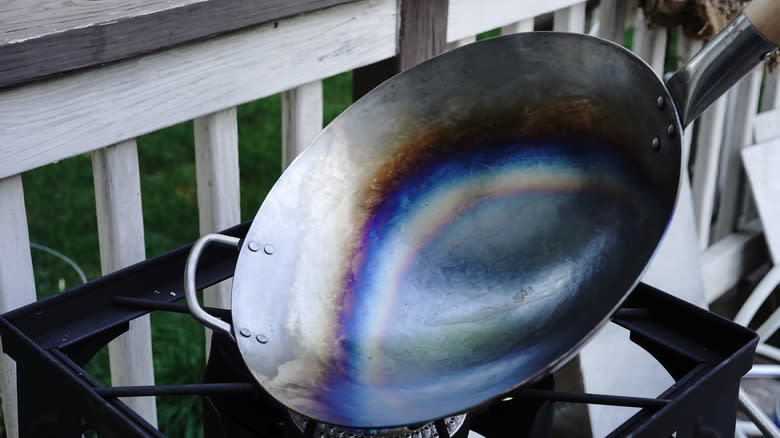
Seasoning your wok is a job that all wok users should learn -- and one that a lot of people fail to do. "The seasoning process creates a patina that protects the inside of the wok," Nami Hirasawa Chen tells us. "This layer of coating prevents rust from moisture and ultimately improves the wok's nonstick capabilities as it's used over time. If it's not seasoned correctly, food will get burned and stuck to the wok."
To season a new wok, you first have to scrub off its anti-rust layer, which is added to stop it from corroding before it's used. You then place your wok over a high heat and allow it to burn. The wok will begin to change color, turning from shiny silver to black. Finally, add some oil to the wok, rub it all over, and then heat it up again. This process causes the oil to soak into the wok's surface, creating that nonstick layer. You only need to do this with certain types of woks, with carbon steel woks generally requiring seasoning. Woks that have already had a nonstick coating added won't need to be seasoned, and doing so could damage their surface.
Purchasing One Made With The Wrong Material
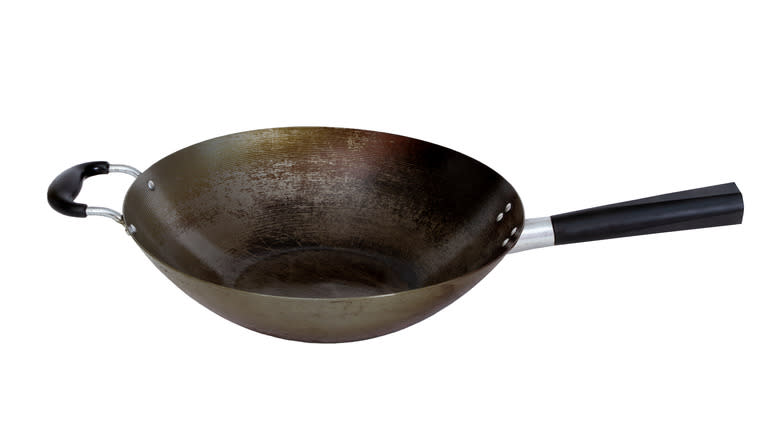
For wok novices, the sheer selection out there with which you can make your stir-fries and pad Thais can be a little scary. This can lead some people to make choices that they later regret -- and one of these choices is buying a wok made with the wrong material. "Nonstick woks struggle with high temperatures, limiting their versatility for various dishes," warns Nami Hirasawa Chen. Although they can be easy to clean, the very nature of wok cooking, which often requires super-high heat, makes them unsuitable. Nami also points out, "Cast iron woks, while excellent at retaining heat, often take longer to heat up and cool down, making it challenging for quick stir-fries or dishes that require rapid cooking."
Instead, go for a carbon steel wok. Carbon steel woks are light yet durable, and this combination makes them perfect for the rapid pace of wok cooking, allowing you to toss your food with ease. "I also find that carbon steel woks heat up faster and distribute heat more evenly, meaning the foods get a nice sear in seconds the moment they touch the heated wok," says Nami. When properly seasoned and cleaned, carbon steel woks can also last for years, making them a cost-effective investment due to their relative inexpensiveness.
Picking The Wrong Size
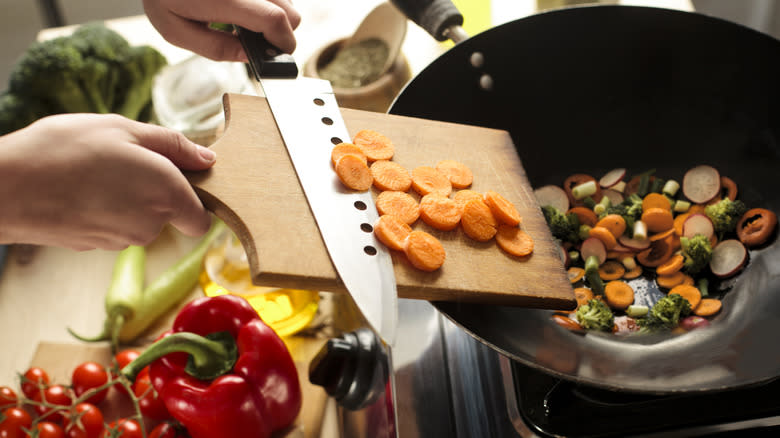
If you've ever seen videos of professional chefs using woks in busy kitchens, you'll have seen how big some of these pans can be. Many commercial-grade woks are around 20 inches in diameter. It can be easy, therefore, to assume that anything smaller than that will be a waste of your time.
Bigger isn't always better, though. Commercial-grade woks are designed to be used over a huge flame produced by a wok burner, which heats the whole thing to a scorching temperature. If you can't produce such heat at home, a massive wok will never be able to get hot enough to cook your food properly.
So, when choosing a wok, think about how hot your stove can get and buy accordingly. Oftentimes, it can be better to get a slightly smaller wok that can get hot enough yet provides enough room to sear your food properly. Aiming for a diameter of about 14 inches can be a good move, although if your stove is particularly modest, you may find that a smaller size is better.
Forgetting To Crank Up The Heat
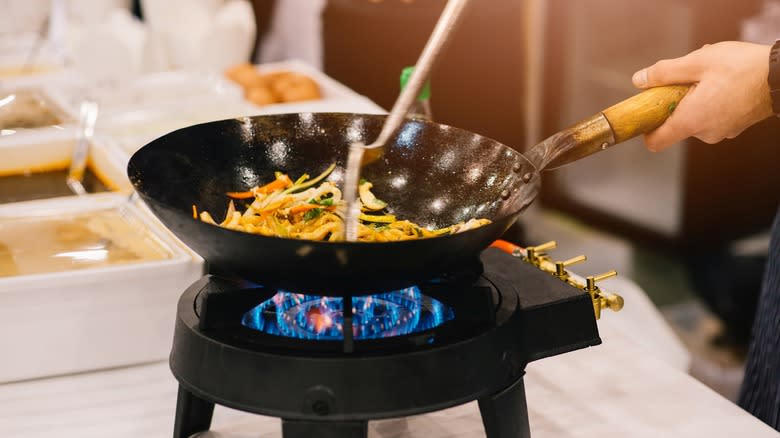
If you've ever wondered why wok-cooked food in restaurants tastes so much better, it could be down to wok hei, the hard-to-define yet perfect flavor only a wok can provide. Nami Hirasawa Chen explains that wok hei refers to a complex, smoky flavor that is provided by getting the wok to an intense heat. This intensity lets the food brown ultra-quickly in your wok, infusing it with immediate caramelization. Without using super-high temperatures, however, your food will never have the depth that wok hei gives it, no matter how much seasoning you add.
So, don't be afraid to flip that heat right up. Place your wok on the largest burner you have and heat it until the pan is smoking. Remember that using a high heat does more than just give your food wok hei, too. "Besides infusing the flavor, cooking protein and vegetables with high heat allows the food to retain moisture, rigidity, and texture," Nami says. "For example, wok stir-fried cabbage will taste crispy and delicious vs. a mushy texture when cooked over low heat. It also helps prevent overcooking your meat when using various proteins."
Using The Wrong Utensils
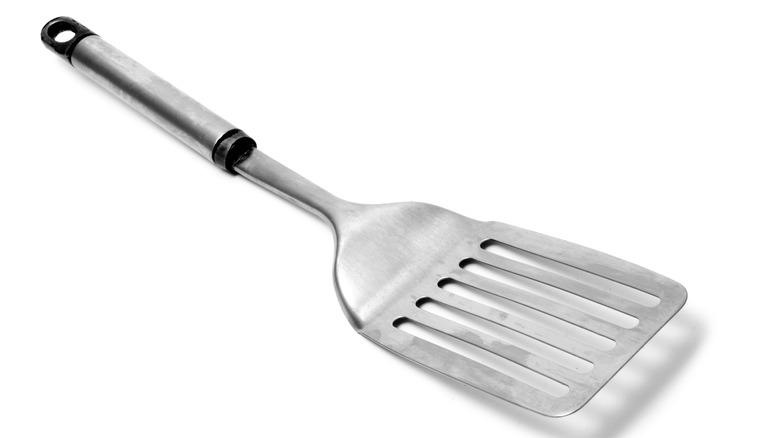
When making a wok-cooked meal, it's always a good idea to get some utensils that are specifically made for use with your pan. Using the wrong utensils can lead to your wok becoming damaged, your food being cooked in a less-than-optimal fashion, or even your hands getting burned. If your spatula's handle is too short, for example, you have to get further into the pan to work with your food, risking scorching your skin. A traditional Chinese spatula, meanwhile, might seem like a great choice, but its shovel shape can scratch the pan's metal surface.
A long-handled flat spatula, designed to flip fish, is going to be your best friend here. These spatulas are slim enough to get under your food, and their shape helps to reduce wear and tear to your pan. It's best to go with a metal spatula here, and not plastic (which can melt thanks to the wok's high heat) or wood (which are generally too thick to flip food properly). Grabbing a long-handled skimmer is always a good idea, as well; these can help you retrieve your food from the wok with more ease. Go for a 4-inch skimmer, or grab a slightly larger 7-inch one if you know you're going to be cooking larger portions.
Adding Your Oil Too Early
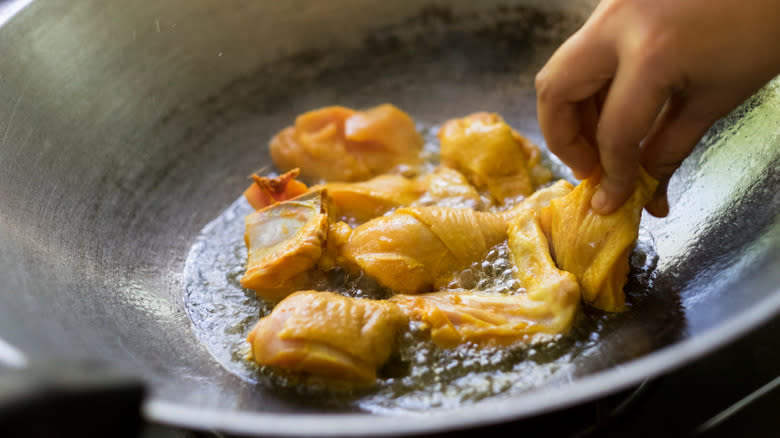
If you're used to adding oil to your pan when it's still cold and heating the two simultaneously, you might want to rethink your approach. When cooking with a wok, you should always add your oil once your pan is super-hot, and not before. "When the wok is hot, you need less oil to spread around compared to when it's cool," says Nami Hirasawa Chen. "This saves on oil and prevents it from burning and giving the food a bad taste."
So, give your wok a minute or two to heat up before adding your oil. Remember that for larger woks, this can take slightly longer than you might think. A good way to check whether it's hot enough is to flick a tiny bit of water onto it -- if it immediately evaporates, the wok's ready to be oiled. It's also important to make sure you're using the right oil, to reduce the likelihood of it burning (and making your food taste awful). A thin oil with a high smoke point, like peanut or canola oil, will be your best friend here.
Overcrowding Your Wok
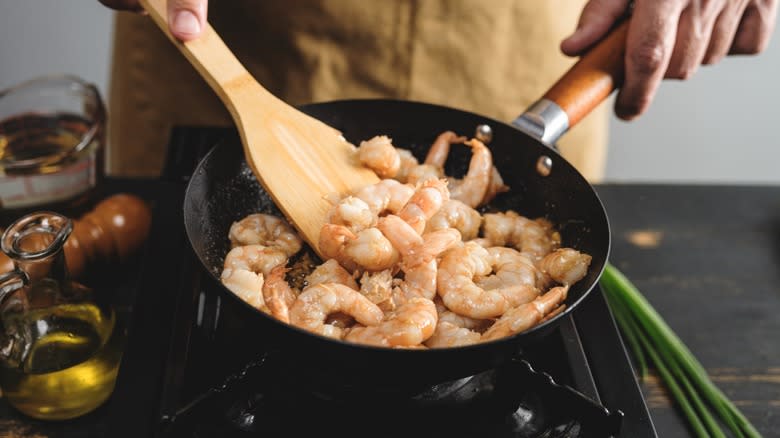
Although using a big wok to make individual portions may feel pretty unnecessary, it's the best way to ensure that your food is delicious -- and doing the opposite by overfilling your wok can lead to disaster. Overcrowding your wok is one of the worst mistakes you can make, as it causes your food to become waterlogged, limp, and flavorless. Everything you cook in your wok will release moisture, and if there are too many objects in it, that moisture won't evaporate properly. Instead, it will pool in the bottom of your wok and prevent your items from searing.
When adding ingredients to your wok, it's always best to assume that less is more. Try to only cook one or two portions at a time in your pan. If your recipe has a large amount of ingredients, you should also consider cooking them in batches instead of adding them all at once, which can cause moisture to build up. Sear your meat or seafood first, followed by your vegetables and aromatics, and then mix everything at the end.
Trying To Flip Your Food Too Much
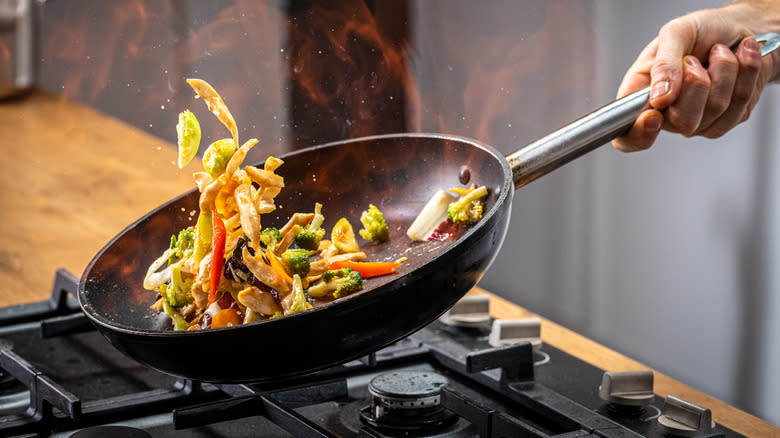
Anyone who's ever seen someone cook with a wok before will know how active the process is. Wok chefs tend to be in a near-constant state of movement, flipping and stirring their food continually. However, although this is necessary to ensure an even browning and cooking over all of your food, you can have too much of a good thing. Trying to flip your food too much can prevent it from developing a proper browning, as it simply doesn't have enough contact time with the metal.
This is particularly important if you have a weaker stove, which can't get your wok to a super-high heat. If this is the case, try to only flip your food now and again, and give your proteins in particular time to brown in one even layer before stirring them. It's also useful to keep flipping to a minimum to avoid the likelihood of spillages and accidents. If you're not careful, you'll end up being a little too overzealous and spilling your food all over your cooktop. This can be more likely if you're using a larger wok, which can be a bit more unwieldy.
Introducing Too Much Moisture To Your Wok
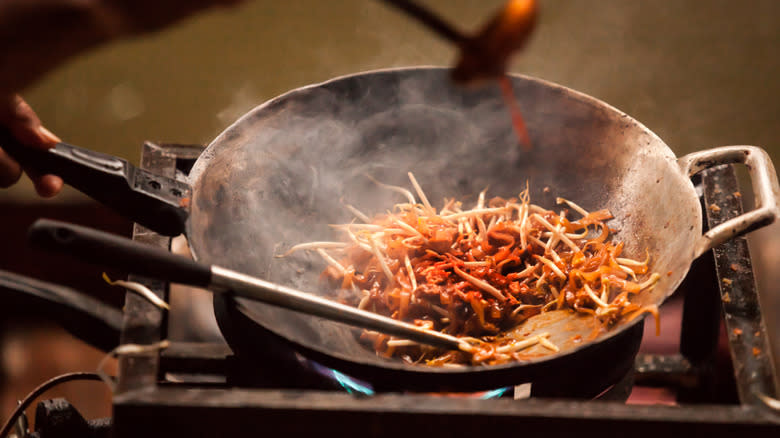
When cooking with a wok, moisture is probably your worst enemy. Even a little bit too much liquid can ruin your food and turn your stir-fry into soup. Although some of this moisture is unavoidable (for example, if it comes from cooking sauces), more often than not, chefs are adding unnecessary water into their pans through poor preparation techniques.
This is why you need to make sure that your ingredients are totally dry before you add them to the pan. After washing and chopping your vegetables, pat them dry with a paper towel, or leave them to air dry until there's no moisture left. You should also always pat your proteins dry, as they can carry a surprising amount of excess water, especially if they've just been thawed.
It's also worth thinking about your seasonings. If you're not following a recipe, and instead just making it up as you go along, it's way too easy to add in too a little too much soy sauce and drench your ingredients. This can make them both way too wet and way too salty. Always add less than you think you need and pour in additional amounts a little at a time.
Using The Wrong Size Ingredients For Your Wok

Proper preparation is everything when it comes to wok cooking, and it all starts with how you chop your ingredients. As everything cooks so quickly in a wok, keeping your food on the heat for even just a few extra seconds can cause it to burn. This is more likely to happen, though, if you chop your ingredients into irregular pieces -- you might find that certain items need longer to cook, and this can come at the expense of others.
The best thing to do is to chop all of your ingredients into equal-sized, small pieces. For your proteins, this will ensure that they cook through quickly, reducing the risk of pink meat or undercooked seafood. For your vegetables, this will help them brown quickly on the outside without getting too soggy on the inside. Make sure you don't chop your food too small, though, or you risk it not having enough bite. A good rule of thumb is to think about whether your items are the right size to be picked up individually by chopsticks (which is, after all, the utensil that might traditionally be used for a lot of wok-cooked dishes).
Adding Your Sauce Directly Into The Middle Of Your Wok
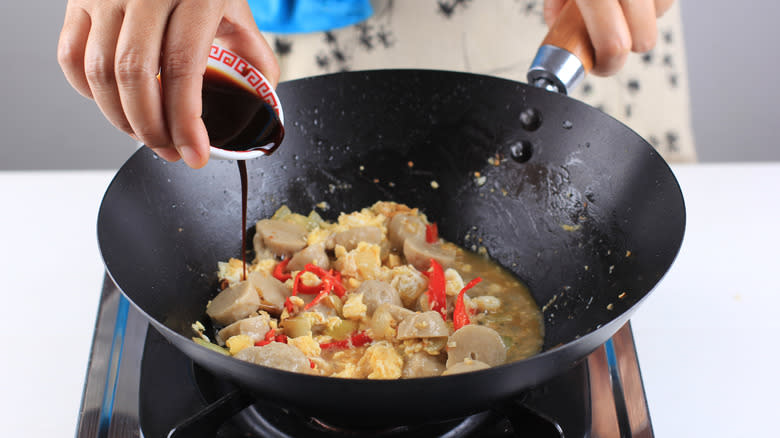
Many wok-cooked dishes are seasoned with sauces, with the sauces' flavor profiles helping to boost the umami taste of your meal while providing necessary moisture. Where you add your sauce, though, is almost as important as which type of sauce you use. If you pour your sauce into the middle of your wok, you bring the wok's central temperature down rapidly, and this drop in heat can cause your ingredients to begin steaming.
Instead, the preferred method is to pour your sauce down one side of the wok. This allows it to heat up quickly while it travels the short distance to your food, keeping your food sizzling and preventing it from getting too wet. Doing this can also create an incredible amount of additional flavor. When you add your sauce to a wok's outer rim, it essentially sears and cooks on its way down to the food. This imbues your sauce with more of the rich wok hei flavors that are essential to wok-cooked dishes and leaves everything so much more complex and tasty. Adding sauce to the middle of your pan prevents this and can make your food taste a little harsh and salty.
Only Using It For Stir-Fries
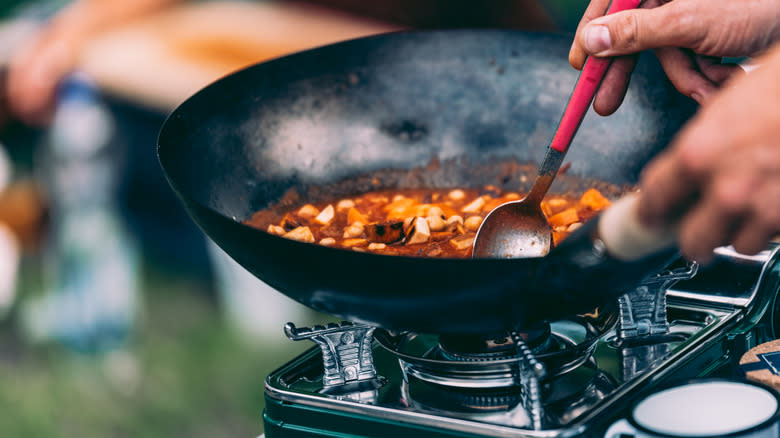
Woks are primarily known for stir-fry cooking, but that's far from the only thing they can be used for. Their high sides and large volume make them the ideal piece of cookware for loads of different cooking styles. "Another reason I love using a carbon steel wok, and woks in general, is their versatility," says Nami Hirasawa Chen. "In addition to stir-frying, they're great for steaming, deep frying, shallow frying, boiling, blanching, smoking and so on."
Pretty much anything can be made in a wok, from fried eggs to an easy beef stew. If you're looking to make a large meal for a crowd, a wok can make an excellent replacement for a casserole dish, especially if you buy a model that has a lid. One thing to watch out for, though, is high-acidity dishes. You should steer clear of cooking acidic dishes in a wok because the acidity can break down the seasoning coating on its inside and cause your food to start to stick.
Cleaning Your Wok Incorrectly
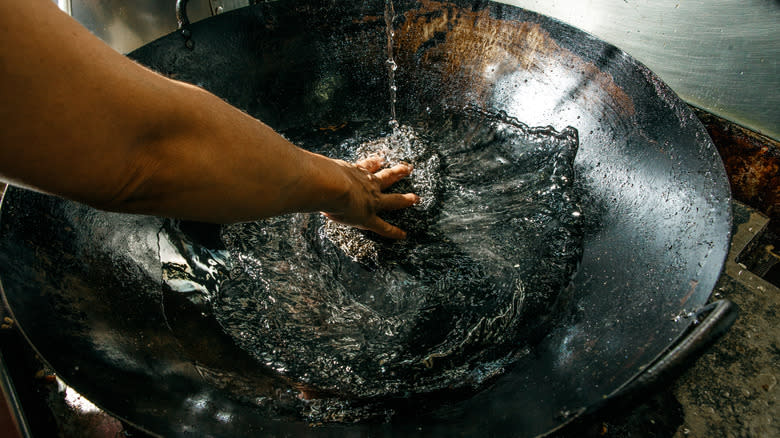
The process of cleaning a wok is a little different from cleaning other pans. When you add an excessive amount of dish soap to a seasoned wok and scrub it too vigorously, it can wear away the patina you've worked so hard to build up through the seasoning and cooking process. As a result, your wok can become more prone to rusting, and your food is more likely to get stuck to its surface.
There's no need to put up with it being filthy, though -- here's how to properly clean that dirty wok: All you have to do is rinse your wok out after use, pouring any detritus down the sink. After this, place it back on your cooktop and use the heat to evaporate the leftover moisture. If you have any food stuck onto the wok's surface, you can cook it out using some water, simmering it for a few minutes until the food dislodges. Avoid dish soap wherever possible, and try to only use it if the meal you cooked is particularly oily, or if it's left a lot of food waste around the outside of the wok.
Read the original article on Daily Meal

 Yahoo Movies
Yahoo Movies 
